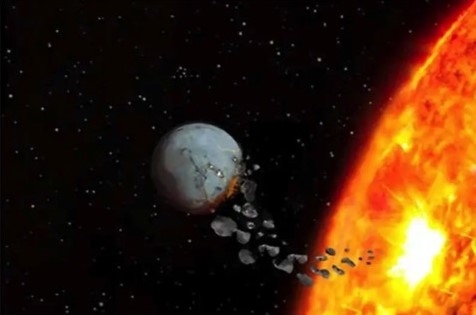

An international team of astronomers investigated the chemical composition of more than 100 binary star systems and detected evidence of planet engulfment by the central star. The discovery has implications for the search for solar systems like our own (artist’s impression of planet engulfment; source: Vanderbilt University)
An international team of astronomers investigated the chemical composition of more than 100 binary star systems and detected evidence of planet engulfment by the central star. The discovery has implications for the search for solar systems like our own.
An international team of astronomers investigated the chemical composition of more than 100 binary star systems and detected evidence of planet engulfment by the central star. The discovery has implications for the search for solar systems like our own.

An international team of astronomers investigated the chemical composition of more than 100 binary star systems and detected evidence of planet engulfment by the central star. The discovery has implications for the search for solar systems like our own (artist’s impression of planet engulfment; source: Vanderbilt University)
By José Tadeu Arantes | Agência FAPESP – In planetary systems with stars similar to the Sun, but with severe dynamic processes that cause reconfigurations of their architecture, some planets may have been engulfed by the host star.
An international team of astronomers led by Lorenzo Spina, of the National Institute for Astrophysics (INAF) in Padua, Italy, and including Jorge Meléndez, of the University of São Paulo’s Institute of Astronomy, Geophysics and Atmospheric Sciences (IAG-USP) in Brazil, studied the chemical composition of Sun-like stars in more than 100 binary systems in search of signatures of planetary engulfment. An article on their research is published in the journal Nature Astronomy.
“In a binary system, both stars are formed from the same material, and they should therefore be chemically identical. However, when a planet falls into a star, it dissolves in the outermost region of the star’s core, known as the convection zone, and can modify the composition of this region by increasing the proportion of chemical elements termed ‘refractory’, which are abundant in rocky planets. Stars with signatures indicating planet engulfment contain more lithium and iron than their twin companion in the binary system,” Meléndez told Agência FAPESP.
Lithium is destroyed in the interior of stars but conserved in the material that makes up planets, he explained, so an abnormally high proportion of lithium in a star might indicate that some of the material came from an ingested planet.
The study was based on observations of 31 binary pairs (and hence of 62 stars) using the HARPS spectrograph on the 3.6-meter telescope at the La Silla Observatory built and operated by the European Southern Observatory (ESO) in Chile. HARPS stands for High Accuracy Radial velocity Planet Searcher. Data collected there was supplemented by data from previous research reported in the scientific literature.
La Silla is in the Atacama Desert, high up in an extremely dry Andean region far away from light pollution. The mountain top has one of the darkest night skies on Earth.
“This was the largest sample ever studied of similar stars in binary systems. The results show that at least a quarter of Sun-like stars ‘devour’ their own planets. The discovery suggests that a significant proportion of planetary systems have a very dynamic past, unlike our Solar System, which has conserved an orderly architecture,” Meléndez said.
According to Spina, first author of the article and principal investigator for the study, “Looking for Earth-like planets is comparable to looking for a needle in a haystack. These findings, however, open up the possibility of using abundances of certain chemical elements to identify stars with a similar composition to the Sun’s.” Stars with comparatively small amounts of refractory elements are more likely to host structures analogous to that of our Solar System.
A well-studied binary system is 16 Cygni, which is some 69 light years from Earth. It has two Sun-like yellow dwarfs, 16 Cygni A and 16 Cygni B, and may also have a red dwarf. The distance between 16 Cygni A and 16 Cygni B is estimated at 860 astronomical units (AU): 1 AU is roughly the distance from Earth to the Sun, or about 150 million km. For the sake of comparison, the distance between the Sun and the Heliopause, the outer edge of the Solar System, is estimated at between 110 AU and 160 AU. Despite the enormous distance between the twin stars, the strongly eccentric orbit of a planet larger than Jupiter around 16 Cygni B may reflect the gravitational disturbance produced by 16 Cygni A.
“It’s worth noting that the component 16 Cygni A, which has no detected planets, is superabundant in refractory elements, suggesting the star may have engulfed planets,” Meléndez said.
The study was supported by FAPESP via the Thematic Project “High-precision spectroscopy: from the first stars to planets”, for which Meléndez is principal investigator.
The article “Chemical evidence for planetary ingestion in a quarter of Sun-like stars” is at: www.nature.com/articles/s41550-021-01451-8.
Republish
The Agency FAPESP licenses news via Creative Commons (CC-BY-NC-ND) so that they can be republished free of charge and in a simple way by other digital or printed vehicles. Agência FAPESP must be credited as the source of the content being republished and the name of the reporter (if any) must be attributed. Using the HMTL button below allows compliance with these rules, detailed in Digital Republishing Policy FAPESP.





